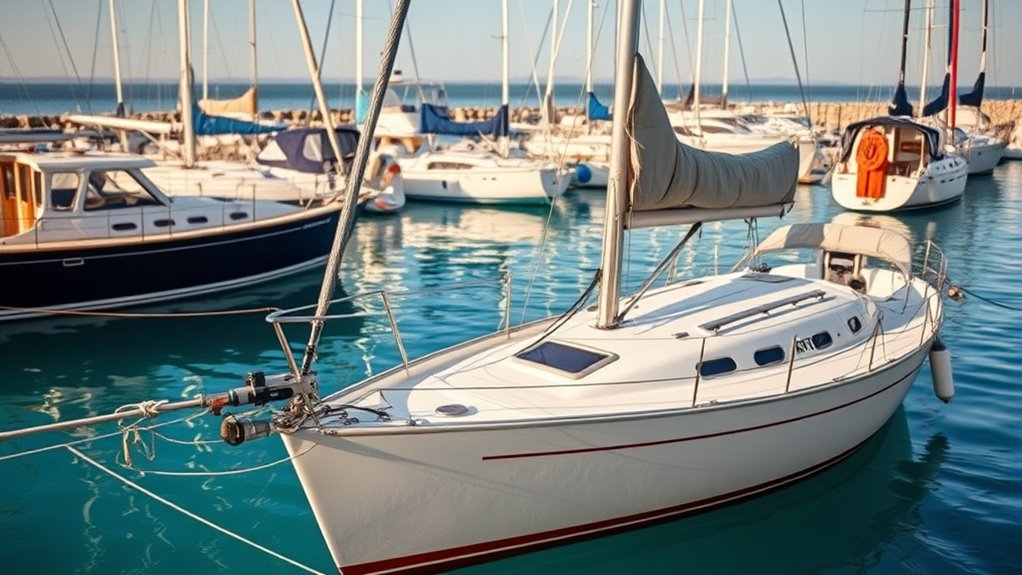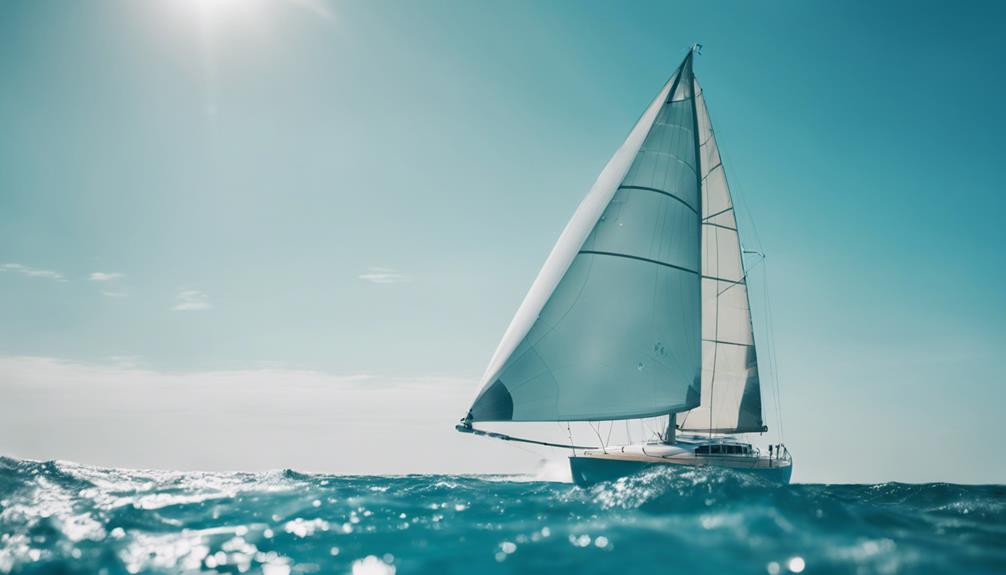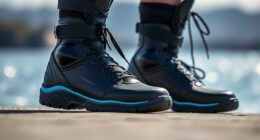To choose a sailboat as a beginner, start by defining your sailing goals and skill level. Consider boat size and capacity to match your typical crew and storage needs, opting for manageable options like dinghies or small monohulls. Focus on safety features, easy handling, and durable materials. Think about your budget and long-term maintenance, and look for boats that are portable and simple to operate. Keep exploring these factors to find the right boat for you.
Key Takeaways
- Assess your sailing goals, experience level, and safety needs to select appropriate boat features and safety equipment.
- Choose a boat size and capacity that match your crew size, storage space, and ease of handling.
- Opt for beginner-friendly boat types like small monohulls, multihulls, or dinghies with simple rigging.
- Consider budget, maintenance, and materials to ensure durability, ease of care, and long-term value.
- Test sail different models and seek expert guidance to evaluate handling, comfort, and suitability for your skill level.
Assess Your Sailing Goals and Experience
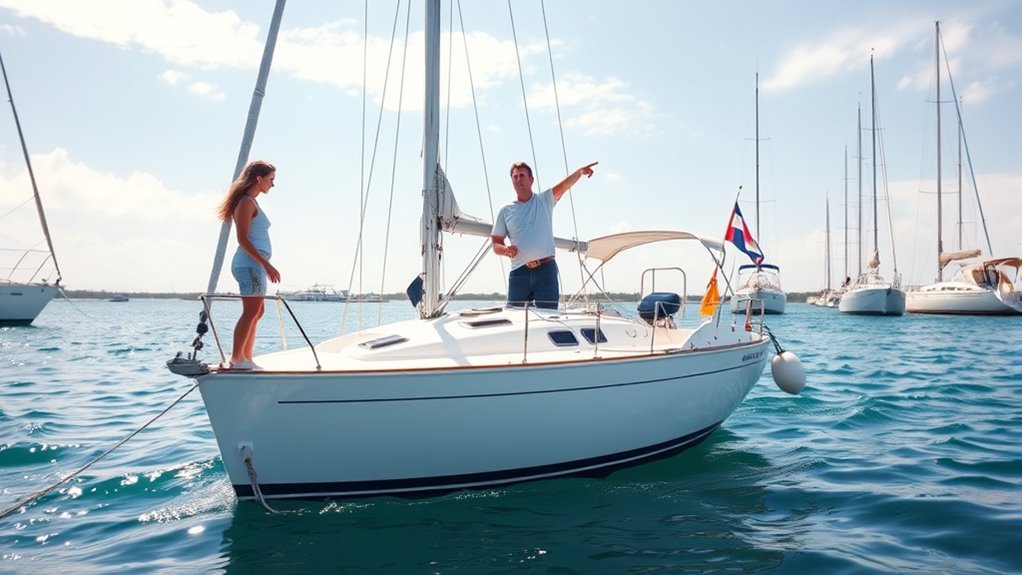
Before choosing a sailboat, you need to clearly define your sailing goals and evaluate your experience level. Are you interested in casual day trips, weekend adventures, or long-distance cruising? Your goals will influence the type of boat you should consider. Additionally, honestly assess your sailing skills—are you a beginner, or do you have some experience handling sails and steering waters? If you’re new, starting with a smaller, manageable vessel helps build confidence and skills. If you’re more experienced, you might look for a boat with advanced features for longer voyages. Understanding what you want to achieve with sailing and your comfort level assures you select a boat that matches your ambitions and capabilities, setting a solid foundation for enjoyable sailing adventures. Furthermore, considering home safety factors such as onboard navigation and safety equipment can significantly enhance your confidence and preparedness on the water. Being aware of Glycolic Acid benefits and applications can also be useful if you plan to maintain your boat’s appearance and protect its surfaces effectively. Additionally, researching frozen yogurt options can inspire ways to treat yourself after a successful day on the water. Exploring different essential oils for maintenance or relaxation can add extra comfort to your sailing experience.
Determine the Ideal Size and Capacity
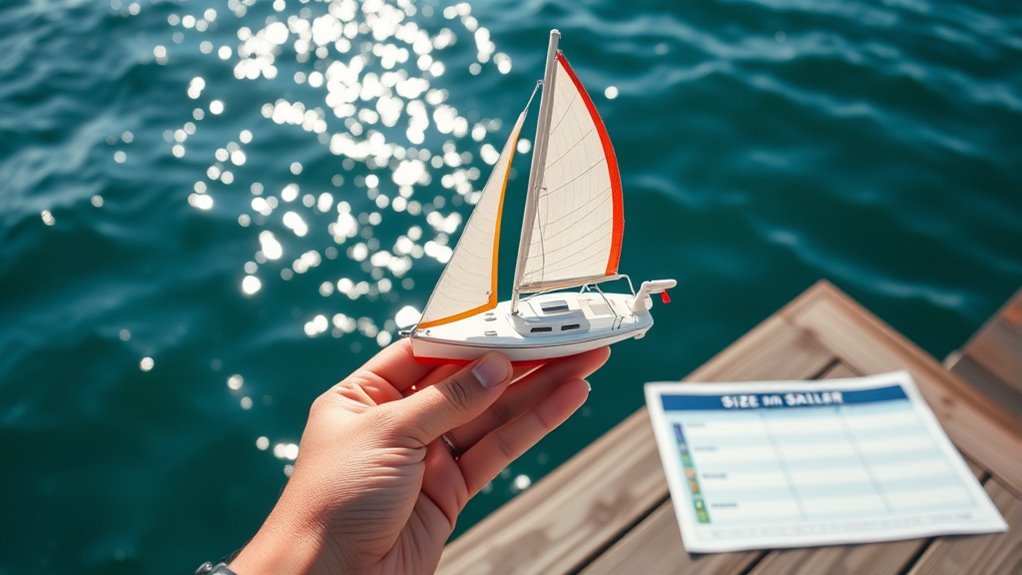
Choosing the right size and capacity for your sailboat is crucial to make certain it meets your sailing needs and comfort level. A boat that’s too small may feel cramped, while one that’s too large can be hard to handle. Consider how many people you’ll usually sail with and your storage needs. For beginners, a boat with a capacity of 4-6 people usually offers a good balance of maneuverability and space. Additionally, understanding the mental wellbeing index can help you gauge your confidence and readiness to handle different boat sizes and conditions.
Understand Different Types of Sailboats
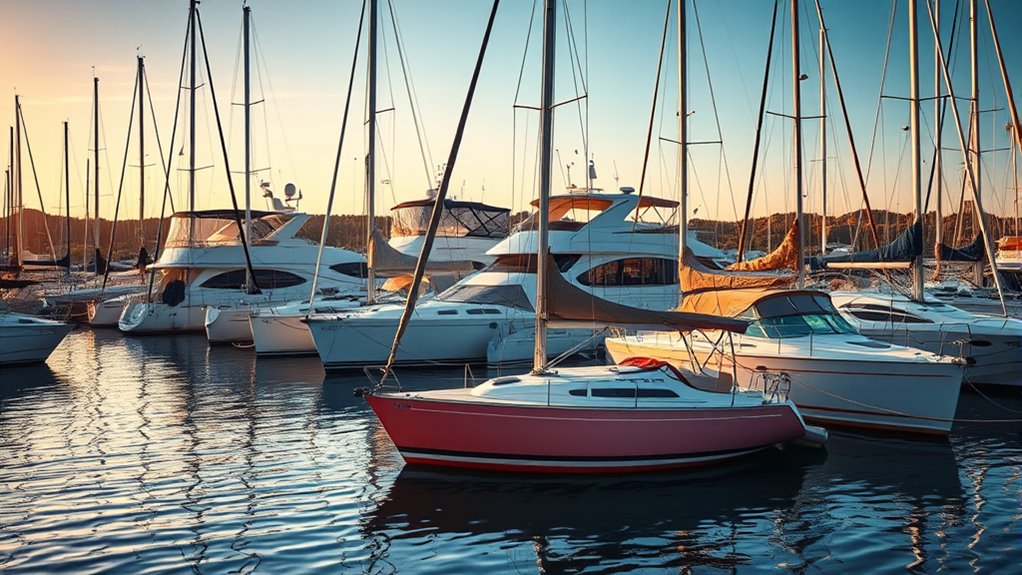
Understanding the different types of sailboats helps you find the best match for your sailing adventures. There are several main types to contemplate: monohulls and multihulls. Monohulls are traditional boats with a single hull, offering a classic sailing experience and good stability. They come in various sizes, suitable for day trips or longer cruises. Multihulls, like catamarans and trimarans, have two or three hulls, providing more stability and speed. They’re often easier to handle and perfect for beginners who want a more comfortable ride. Dinghies are small, lightweight boats ideal for practice and short distances. Each type suits different skill levels and activities, so understanding their features helps you choose a boat that matches your comfort, experience, and upcoming adventures. For beginners, choosing a boat with reliable heat pump features can also make your sailing experience more comfortable and energy-efficient when docked or during longer stays. Additionally, selecting a sailboat with proper safety features is essential to ensure a secure and enjoyable sailing experience for novices. Recognizing the different hull configurations can also assist in selecting a boat that aligns with your intended use and skill level. Moreover, understanding modern navigation technology can greatly enhance safety and ease of handling for new sailors. An awareness of environmental impact considerations can also help you choose more sustainable options and reduce your ecological footprint while sailing.
Consider Your Budget and Long-Term Investment
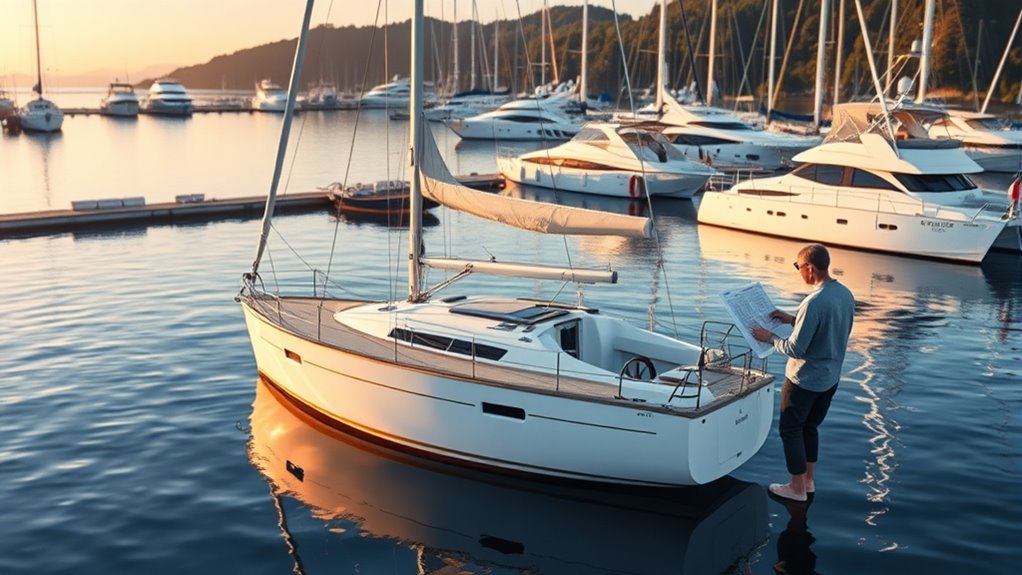
Your budget plays a crucial role in selecting the right sailboat, as it determines what options are realistically within your reach. Be honest about how much you can spend upfront and consider future expenses like maintenance, gear, and storage. While it might be tempting to buy a cheaper boat, remember that quality and durability matter, especially for beginners. Investing in a slightly higher-priced, reliable vessel can save you money on repairs and replacements later. Think about your long-term plans: will you want to upgrade or sell the boat down the line? A well-chosen sailboat can hold its value and serve you for years. Additionally, exploring resale value concerns can help you find a vessel that offers a good balance of quality and affordability. When considering the locations of gumball machines, choosing a boat that can be easily stored and maintained in accessible areas can also impact your long-term satisfaction. Balancing your current budget with future investment ensures you enjoy sailing without financial stress, and understanding the affordability of maintenance is essential for planning your ongoing costs. Proper maintenance and selecting a durable boat can also reduce long-term expenses, making your investment more worthwhile.
Evaluate Ease of Handling and Maintenance
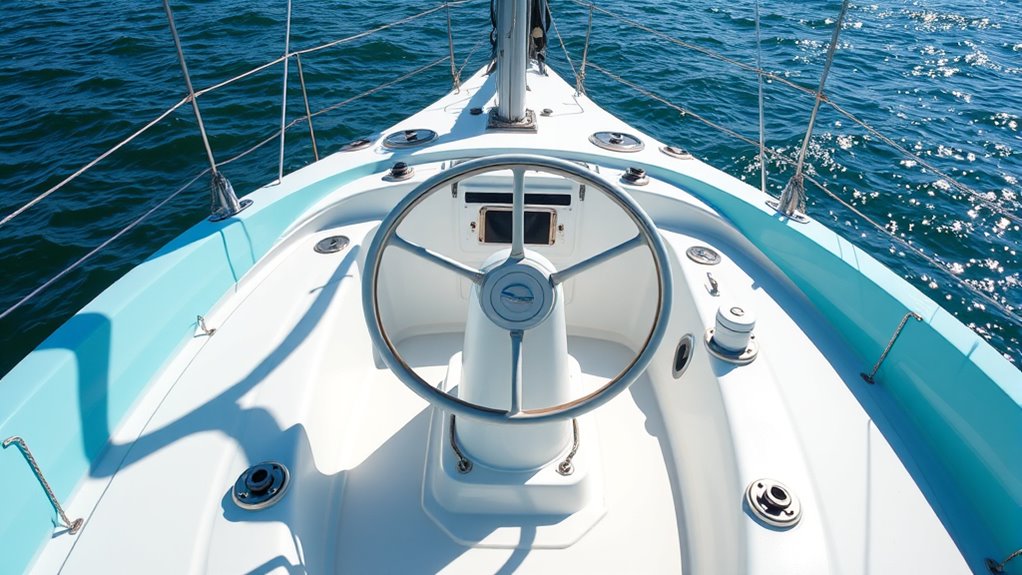
When selecting a sailboat, it’s important to consider how easy it is to handle on your own and what maintenance tasks you’ll face regularly. Look for features designed for simplicity and assess the overall upkeep required to keep the boat in good condition. Keep in mind your comfort level with learning new skills and how quickly you’ll adapt to managing the boat safely. Additionally, understanding the importance of lifestyle factors such as ease of remote management and customization options can help you choose a boat that fits your routine and enjoyment preferences. Recognizing family dynamics involved in boat ownership can also influence your decision, especially if you plan to share sailing experiences with others. Considering the initial investment and ongoing costs is essential to ensure your choice aligns with your budget and long-term plans. Being aware of maintenance requirements can further guide you toward a boat that matches your desired level of involvement and expertise.
Ease of Handling Features
Ease of handling is a crucial factor when choosing a beginner sailboat, as it directly impacts your confidence and safety on the water. Look for features that make steering, trimming, and maneuvering straightforward. A boat with responsive and balanced steering helps you stay in control, especially in changing conditions. Clear, accessible controls for sail trim allow you to adjust easily without hassle. Consider how simple it is to handle the boat solo or with a small crew, which boosts your confidence as a beginner.
- Responsive steering for better control
- Easy-to-reach sail adjustments
- Stable hull design for smoother handling
Maintenance Requirements Overview
Maintaining a sailboat can considerably influence your overall sailing experience, especially for beginners. The ease of maintenance depends on the boat’s size, materials, and design. Smaller boats generally require less upkeep and are easier to inspect regularly. Look for boats with simple rigging and accessible components, which make routine tasks like cleaning, checking for corrosion, and replacing parts straightforward. Marine-grade materials like fiberglass are durable and low-maintenance, reducing the time and effort needed for repairs. Regularly cleaning the hull, inspecting lines, and checking fittings prevent bigger issues down the line. Low-maintenance materials such as fiberglass help minimize the need for frequent repairs and upkeep, making your sailing experience more enjoyable. Understanding the benefits of low-maintenance materials can help you select a boat that minimizes upkeep and maximizes your sailing enjoyment. Additionally, choosing a boat with simpler systems can further reduce the complexity of ongoing maintenance tasks.
Learning Curve Considerations
Choosing a sailboat that’s right for beginners means considering how easy it is to handle and maintain. A boat with a gentle learning curve lets you gain confidence faster and enjoy sailing more. Look for models with simple rigging, responsive steering, and straightforward controls. Ease of maintenance also plays an essential role, as boats requiring less upkeep save you time and money. To assess the learning curve, consider these factors:
- How intuitive the boat’s controls are for new sailors
- The complexity of rigging and sail management
- The frequency and difficulty of routine maintenance tasks
Prioritizing these aspects helps you select a boat that supports your skill development without overwhelming you. A manageable learning curve ensures you stay motivated and become a confident sailor sooner.
Choose the Right Material and Construction
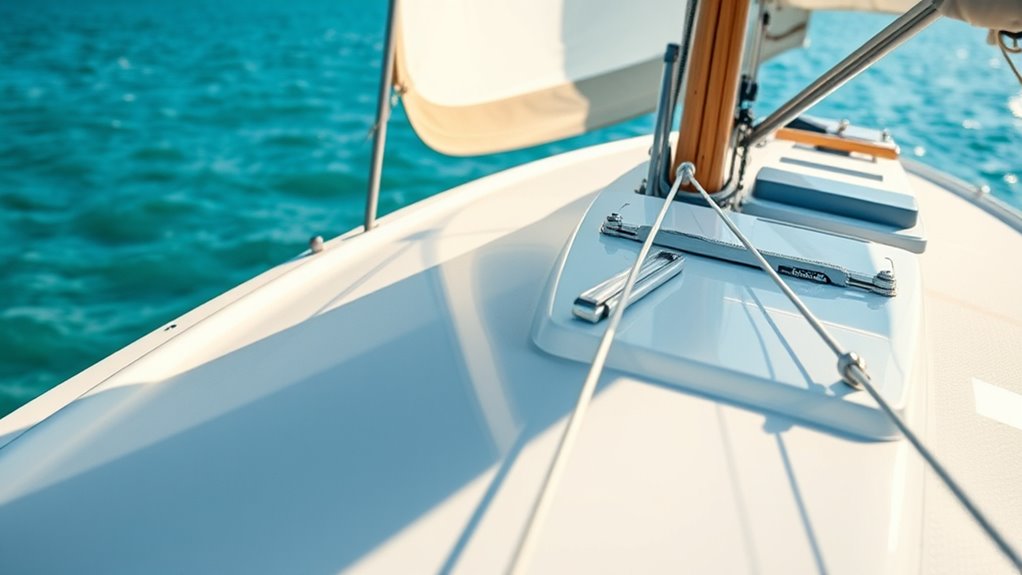
When selecting a sailboat, consider the materials used for durability and weight, as these factors affect performance and longevity. You should also pay attention to construction quality and design, which influence how well the boat handles and withstands the elements. Making informed choices here helps guarantee your boat is reliable and easy to maintain for beginners.
Material Durability and Weight
Selecting the right material for your sailboat is crucial because it directly impacts durability and ease of handling. You want a material that can withstand the elements without adding unnecessary weight, making your sailing experience safer and more enjoyable. Lighter materials like fiberglass offer strength without excessive weight, improving maneuverability. Heavier materials, such as wood, provide durability but can be harder to handle and transport. Consider how often you’ll sail and the typical conditions—this helps determine the best balance between durability and weight. Keep in mind that lighter boats are easier to launch and store, but may require more maintenance. Ultimately, choosing a material suited to your skill level and sailing plans ensures your boat remains reliable and manageable.
- Resists weather and corrosion
- Balances weight for easier handling
- Requires minimal maintenance
Construction Quality and Design
How you evaluate construction quality and design can make a big difference in your sailing experience. Look closely at how the boat is built—strong joints, quality seams, and durable hardware matter. Check the materials used, like fiberglass, aluminum, or wood, and consider their resistance to weather and wear. A well-designed boat will balance stability, ease of handling, and safety. Pay attention to the hull shape, keel type, and cockpit layout, making sure they suit your skill level and planned outings. Avoid boats with cheap fittings or visible flaws, as these can lead to problems later. Ultimately, a sturdy construction combined with thoughtful design ensures your boat performs reliably and keeps you safe on the water.
Think About Storage and Portability
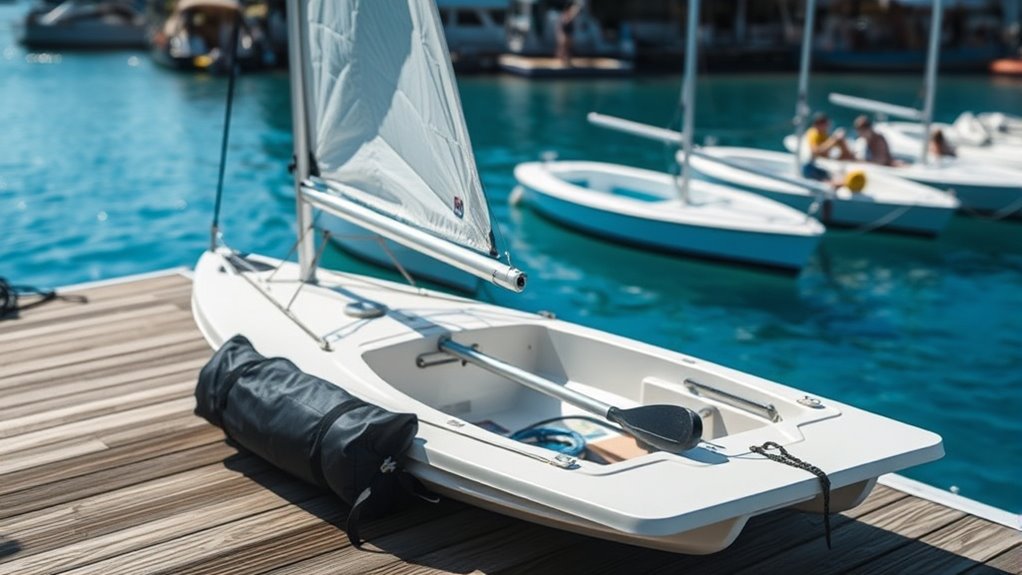
Considering storage and portability is essential when choosing a beginner sailboat, as these factors directly impact your ease of transportation and maintenance. A boat that’s easy to store means less hassle when not in use, and portability ensures you can transport it to different locations without special equipment. Look for boats that break down into manageable parts or are lightweight enough for your vehicle.
- Opt for modular designs that can be disassembled quickly
- Choose lightweight materials for easier handling
- Consider size limitations of your storage space and vehicle
Research Safety Features and Equipment
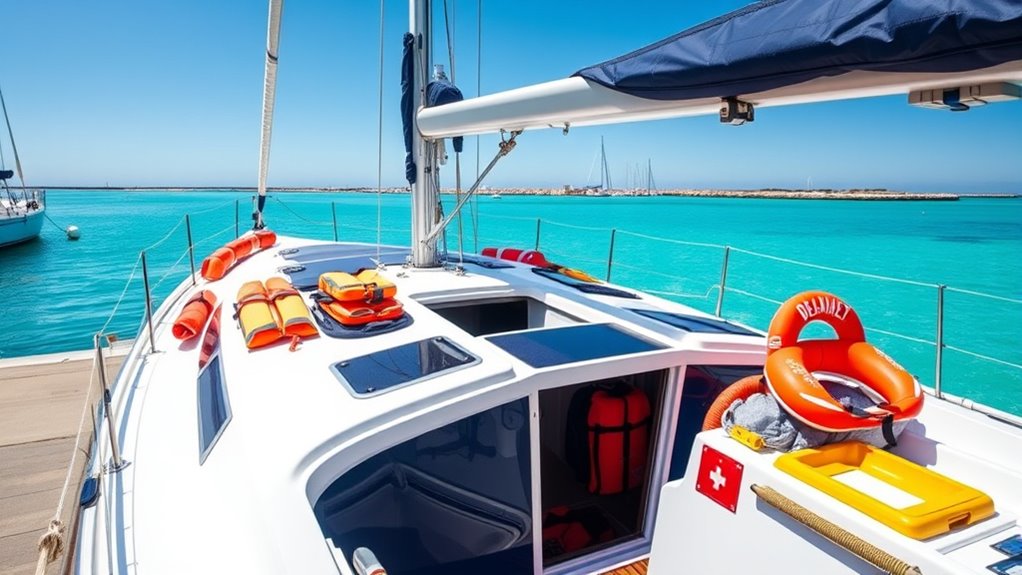
When evaluating different beginner sailboats, paying attention to safety features and equipment can make all the difference in your confidence on the water. Look for boats equipped with essential safety gear like life jackets, a throwable flotation device, and a first aid kit. Make certain the boat has reliable navigation lights, a whistle or horn, and clear marking of emergency exits. Check that the boat’s hardware is sturdy and corrosion-resistant, especially the rigging and fittings. Consider if it has a built-in bilge pump or manual bailers to remove water quickly. Additionally, verify that safety instructions and equipment are easily accessible and well-maintained. Prioritizing these features helps you stay prepared for unexpected situations, making your sailing experience safer and more enjoyable.
Seek Expert Advice and Test Sailboats Before Buying
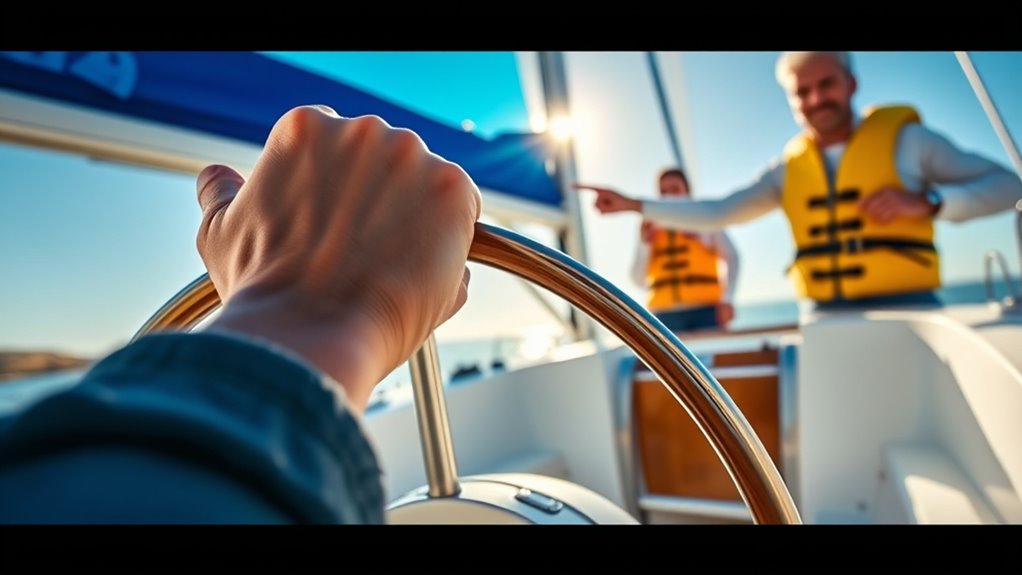
Seeking expert advice can provide valuable insights that you might not discover through alone research, ensuring you choose a sailboat suited to your skill level and needs. Talking to seasoned sailors or visiting reputable dealers helps you understand different boat types, features, and what to avoid. Test sailing is essential; it allows you to experience how the boat handles, its comfort, and responsiveness firsthand. Before making a decision, consider these key aspects:
Consult experienced sailors and test sail to choose the right sailboat confidently.
- Ask experienced sailors for recommendations based on your skill level
- Take multiple test sails to compare performance and comfort
- Review maintenance requirements and long-term costs
Frequently Asked Questions
What Are the Common Beginner Mistakes to Avoid When Choosing a Sailboat?
When choosing a sailboat as a beginner, you should watch out for common mistakes. Don’t overlook the importance of size; opting for a boat that’s too big can make handling difficult. Avoid disregarding your skill level and ignoring stability features. Also, steer clear of boats with complicated rigs and poor maintenance history. By focusing on a manageable size, stability, and ease of use, you set yourself up for a safer, more enjoyable sailing experience.
How Do Weather Conditions Influence Sailboat Selection for Beginners?
Weather conditions play a vital role in your sailboat choice. If you often sail in calm, predictable weather, a smaller, easier-to-handle boat is ideal. For more variable, stronger winds, opt for a sturdier, slightly larger craft with better stability. Always consider seasonal weather patterns in your area. By matching your boat to local conditions, you’ll sail safely and enjoy your experience more confidently.
What Warranties or After-Sales Support Should I Look For?
Think of warranties and after-sales support as your safety net, much like a trusted crew member. You should look for thorough coverage that includes repairs, parts, and maintenance. guarantee the manufacturer offers prompt customer service and clear communication channels. A solid warranty gives you peace of mind, knowing help is just a call away if issues arise. Prioritize brands with good reputations for after-sales support to keep your sailing adventures smooth.
Are Used Sailboats a Good Option for Beginners?
Used sailboats can be a good option for beginners if you carefully inspect their condition and history. They’re usually more affordable, letting you learn without a huge investment. However, you should look for signs of wear, corrosion, and guarantee proper maintenance records. Taking a knowledgeable friend or a marine surveyor with you can help identify potential issues, so you make a confident choice that fits your skill level and budget.
How Does Local Sailing Environment Impact My Boat Choice?
Imagine your sailing journey as a dance across different waters. The local environment shapes your moves—calm lakes call for smaller, stable boats, while choppy coastal waters demand sturdier, more powerful vessels. You’ll want to choose a boat that responds smoothly to the environment’s rhythm, ensuring safety and ease. By understanding your local conditions, you select a boat that feels like an extension of your own skill and confidence on the water.
Conclusion
Choosing your first sailboat is like setting sail on a new adventure; each decision is a guiding star leading you to calmer waters. Trust your goals, handle with care, and seek advice like a seasoned captain. With patience and knowledge, you’ll navigate the vast ocean of options and find the perfect vessel to carry you through countless journeys. Remember, the right boat isn’t just a vessel—it’s your trusted companion on the open waters.

